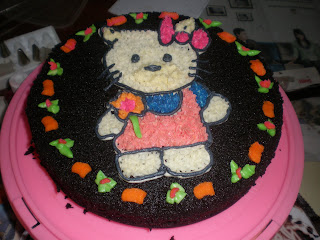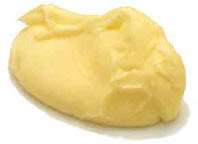BUTTER CAKE TOPPED WITH FONDANT
Thursday, January 31, 2008
Tuesday, January 29, 2008
Monday, January 28, 2008
CHARACTER CAKES
When Spiderman movie was a hit, children were also dressed up in spiderman attire. So does the cake for birthday. One of my artwork... The Spiderman Cake topped with buttericing.
Sunday, January 27, 2008
Resepi Kek Marble

Resepi ini dari Alaf21.
Kek Marble
250 g mentega
130 g gula halus
3 camb susu pekat
1 camb ovalette
3 biji kuning telur Gred A
230 g tepung naik sendiri
1 camt vanila
1-2 camt chocolate emulco
3 biji putih telur Gred A
Cara-caranya:
Pukul mentega, gula dan susu hingga kembang dan ringan. Masukkan ovalette, pukul lagi kelajuan maksima selama 5 minit. Masukkan sebiji demi sebiji kuning telur, putar rata. Akhir sekali, bubuh tepung dan vanila. Kacau rata. Pukul putih telur hingga kental, kaupbalikkan ke dalam adunan tadi. Bahagikan 2, masukkan emulco ke dalam satu bahagian. Sudukan secara berselangseli ke dalam tin 20 cm yang dialas kertas kalis minyak dan dilengser marjerin. Bakar pada 190 C selama 40-45 minit atau hingga masak.
Pukul mentega, gula dan susu hingga kembang dan ringan. Masukkan ovalette, pukul lagi kelajuan maksima selama 5 minit. Masukkan sebiji demi sebiji kuning telur, putar rata. Akhir sekali, bubuh tepung dan vanila. Kacau rata. Pukul putih telur hingga kental, kaupbalikkan ke dalam adunan tadi. Bahagikan 2, masukkan emulco ke dalam satu bahagian. Sudukan secara berselangseli ke dalam tin 20 cm yang dialas kertas kalis minyak dan dilengser marjerin. Bakar pada 190 C selama 40-45 minit atau hingga masak.
Melapis adunan kek.
Sedia untuk dibakar.

Saturday, January 26, 2008
Why does my cake crack?

Quoted from : nestle.com
The most common cause of a crack in the surface of the cake is baking in an oven that is too hot. The surface of the cake sets very quickly, before the inside of the cake has had time to expand fully. Then as the inside of the cake heats up and starts to rise it has to break through the crust to have the space to expand. This tends to give a volcano look to the cake with the inside of cake spilling out of the crack.Actual oven temperatures often vary from the setting on the dial and it would seem that your oven might be running a little hot. Try setting it a little below the temperature stated in the recipe next time you bake a cake. Also take care to bake the cake in the center of the oven, not too close to the top where the temperature is highest.Another cause could be over-dosing on leavener e.g. baking powder or baking soda, so always measure these ingredients carefully.
BIRTHDAY CAKES
My CAKES IN THE OVEN
My first bake when I was 15 years old. "Kek Milo" a recipe from a tv programme. It surprised my mother. Using marjerin, as in those years butter was not that a fame in kampung. However, the cake had a soft texture, and the taste was great. I'm not going to share the recipe of Kek Milo as I can't remember the recipe.
I love butter cakes. Butter cake gives the "original" cake taste, its aroma travels your neighbourhood and makes one wondering - Who's baking hah....??? A Number of butter and marjering products, therefore we may want to know what best for your baking.
For making a butter cake the taste lies on the butter used. Let us have some reading on the butter and margarine captured from various websites.
"Butter comes in two forms salted and unsalted (sweet). Unsalted butter has a shelf life of around 3 months refrigerated because it contains no preservatives. Salted butter has a longer shelf life (up to 5 months) because salt acts as a preservative. However, salt can overpower the sweet flavor of the butter and can also mask any odors. The amount of salt added to salted butter can vary from manufacturer to manufacturer and it is hard to know how much extra salt to add to your recipe. The rule of thumb is that if you are substituting salted for unsalted butter in a recipe, omit the extra salt in the recipe (i.e. Omit ¼ teaspoon of salt per 1/2 cup (113 grams) of butter).
Most butter has an expiry date on it. It should be stored well-wrapped in foil away from any strong odors and in the coldest part of the refrigerator. Foil is used to prevent exposure to light and air which can cause the butter to oxidize and become stale. Check your butter's freshness by cutting a small slice and the outside of the butter should be the same color as the inside. If the outside is a darker color than the inside the butter has oxidized. You can freeze butter for around six months. Just make sure you defrost the butter overnight in the refrigerator before using it. It is best not to use butter that has been frozen for baking, as freezing can affect the texture of the butter and change its moisture content. When the butter thaws it can be grainy with droplets of water.
Butter adds flavor and texture to your baking and helps to keep it fresh. The temperature of the butter is very important in baking. When room temperature butter is used in your recipe this means your butter should be between 65 degrees F (18 degrees C) and 70 degrees F (21 degrees C). This temperature allows the maximum amount of air to be beaten into your batter. This creaming or beating of your butter or butter and sugar creates air bubbles that your leavener (baking powder or baking soda) will enlarge during baking. Most experts recommend 4 to 5 minutes of creaming the butter for maximum aeration.
Margarine, a butter substitute made originally from other animal fats, but nowadays exclusively from vegetable oils, is, like homogenization and pasteurization, a French innovation.
Like its model, margarine is about 80% fat, 20% water and solids. It is flavored, colored, and fortified with vitamin A and sometimes D to match butter's nutritional contribution. A single oil or a blend may be used. During World War I, coconut oil was favored; in the thirties, it was cottonseed, and in the fifties, soy. Today, soy and corn oils predominate. The raw oil is pressed from the seeds, purified, hydrogenated, and then fortified and colored, either with a synthetic carotene or with annatto, a pigment extracted from a tropical seed. The water phase is usually reconstituted or skim milk that is cultured with lactic bacteria to produce a stronger flavor, although pure diacetyl, the compound most responsible for the flavor of butter, is also used. Emulsifiers such as lecithin help disperse the water phase evenly throughout the oil, and salt and preservatives are also commonly added. The mixture of oil and water is then heated, blended, and cooled. The softer tub margarines are made with less hydrogenated, more liquid oils than go into stick margarines"
Like its model, margarine is about 80% fat, 20% water and solids. It is flavored, colored, and fortified with vitamin A and sometimes D to match butter's nutritional contribution. A single oil or a blend may be used. During World War I, coconut oil was favored; in the thirties, it was cottonseed, and in the fifties, soy. Today, soy and corn oils predominate. The raw oil is pressed from the seeds, purified, hydrogenated, and then fortified and colored, either with a synthetic carotene or with annatto, a pigment extracted from a tropical seed. The water phase is usually reconstituted or skim milk that is cultured with lactic bacteria to produce a stronger flavor, although pure diacetyl, the compound most responsible for the flavor of butter, is also used. Emulsifiers such as lecithin help disperse the water phase evenly throughout the oil, and salt and preservatives are also commonly added. The mixture of oil and water is then heated, blended, and cooled. The softer tub margarines are made with less hydrogenated, more liquid oils than go into stick margarines"

Classic Butter Cake
250 gm Butter
200 gm castor sugar
250 gm Superfine Flour
5 eggs
1 tsp of baking powder
1/4 cup of fresh milk 1 tsp vanila essence
Method:
1. Beat butter with sugar using until sugar dissolved.
2. Add eggs one after another. Blend well and add the vanila essence.
3. Add flour alternately with fresh milk.
4. Line based of 8" round tin. Pour in the batter and bake in a preheated oven at 170C until done.
Subscribe to:
Comments (Atom)
 "
"







